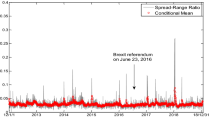Summary
In this paper a model of the exchange rate is developed from trading rules principles. The model is empirically implemented for the German Mark-US Dollar and US Dollar-UK Pound exchange rates using monthly data, over the period June 1978 to December 1982. In terms of forecasting performance and accuracy, the simple trading model is shown to outperform the forward foreign exchange rate.
Similar content being viewed by others
References
Baillie, R.J., R.E. Lippens and P.L. McMahon, ‘Testing Rational Expectations and Efficiency in the Foreign Exchange Market,’Econometrica, 51 (1983), pp. 553–63.
Barro, R.J., ‘Unanticipated Money Growth and Unemployment in the United States,’American Economic Review, 67 (1977), pp. 101–115.
Blanchard, O., ‘Credibility and Gradualism,’ Unpublished Manuscript, Harvard University, (1982).
Bomhoff, E.S. and P. Korteweg, ‘Exchange Rate Variability and Monetary Policy Under Rational expectations: Some Euro-American Experience 1973–1979,’ Paper Presented at the Konstanzer Seminar on Monetary Theory and Monetary Policy, Konstanz, June, 1980.
Branson, W.H., ‘Macroeconomic Determinants of Real Exchange Risk,’ in: R.J. Herring (ed.),Managing Foreign Exchange Risk, Cambridge, 1983.
Copeland, L., ‘The Pound Sterling and the News: A Test of an Unobservable Theory,’Economics Letters, 1984.
Cornell, B., ‘Money Supply Announcements and Interest-Rates: Another View,’Journal of Business, 56 (1983) pp. 1–23.
Dooley, M.P. and J.R. Shafer, ‘Analysis of Short-Run Exchange Rate Behaviour, March 1973 to September 1975,’ International Finance Discussion Papers, No. 76, (1976).
Dooley, M.P. and J.R. Shafer, ‘Analysis of Short Run Exchange Rate Behaviour: March 1973 to November 1981,’ in: D. Bigman and T. Taya (eds.),Exchange Rate and Trade Instability, 1983, pp. 43–69.
Dornbusch, R., ‘Exchange Rate Economics: Where Do We Stand?,’Brookings Papers on Economic Activity, 1 (1980), pp. 143–185.
Dornbusch, R., ‘Flexible Exchange Rates and Interdependence,’I.M.F. Staff Papers, 30 (1983), pp. 3–30.
Edwards, S., ‘Exchange Rates and ‘News’: A Multi-Currency Approach,’Journal of International Money and Finance, 1 (1983), pp. 211–224.
Frenkel, J.A., ‘Tests of Rational Expectations in the Forward Exchange Market,’Southern Journal of Economics, (1979), pp. 1083–1101.
Frenkel, J. A., ‘Flexible Exchange Rates, Prices, and the Role of ‘News’: Lessons from the 1970s,’Journal of Political Economy, 89 (1981), pp. 665–705.
Gweke, J. and E. Fiege, ‘Some Joint Tests of Markets for Forward Exchange,’Review of Economics and Statistics, 70 (1978), pp. 334–41.
Hakkio, G.S., ‘The Term Structure of the Forward Premium,’Journal of Monetary Economics, 8 (1981), pp. 41–58.
Hansen, L.P. and R.J. Hodrick, ‘Forward Exchange Rates as Optimal Predictors of Future Spot Rates: An Econometric Analysis,’Journal of Political Economy, 88 (1980), pp. 829–853.
Levich, R.M., ‘Tests of Forecasting Models and Market Efficiency in Five International Money Markets,’ in: J.A. Frenkel and H.G. Johnson,The Economics of Exchange Rates, Reading, 1978, pp. 129–158.
Levich, R.M., ‘On the Efficiency of Markets for Foreign Exchange’, in: R. Dornbusch and J.A. Frenkel (eds.),International Economic Policy Theory and Evidence, Baltimore, Md,1979, pp. 246–267.
Levich, R.M., ‘How the Rise of the Dollar Took Forecasters by Surprise,’Euromoney, 1982, pp. 98–111.
Logue, D.E. and R.J. Sweeney, ‘White Noise in Imperfect Markets: The Case of the Franc/Dollar Exchange Rate,’Journal of Finance, 32 (1977), pp. 761–768.
MacDonald, R., ‘Some Tests of the Rational Expectations Hypothesis in the Foreign Exchange Market,’Scottish Journal of Political Economy, 30 (1983A), pp. 235–250.
MacDonald, R., ‘Tests of Efficiency and the Impact of News in Three Foreign Exchange Markets: The Experience of the 1920s,’Bulletin of Economic Research, 35 (1983B), pp. 123–144.
Makin, J.H., ‘Effects of Inflation Control Programs on Expected Real Interest Cases,’IMF Staff Papers, 29 (1982), pp. 204–232.
Mussa, M., ‘Macroeconomic Interdependence and the Exchange Rate Regime,’ in: R. Dornbusch and J.A. Frenkel (eds.),International Economic Policy Theory and Evidence, Baltimore, Md, 1979, pp. 160–208.
Poole, W., ‘Speculative Prices on Random Walks: An Analysis of Ten Time Series of Flexible Exchange Rates,’Southern Economic Journal, 33 (1967).
Rose, A.K., ‘Testing for ‘News’ in Foreign Exchange Markets,’Economics Letters, 14 (1984), pp. 369–376.
Author information
Authors and Affiliations
Rights and permissions
About this article
Cite this article
MacDonald, R., Young, R. Decision rules, expectations and efficiency in two foreign exchange markets. De Economist 134, 42–60 (1986). https://doi.org/10.1007/BF01705901
Issue Date:
DOI: https://doi.org/10.1007/BF01705901



